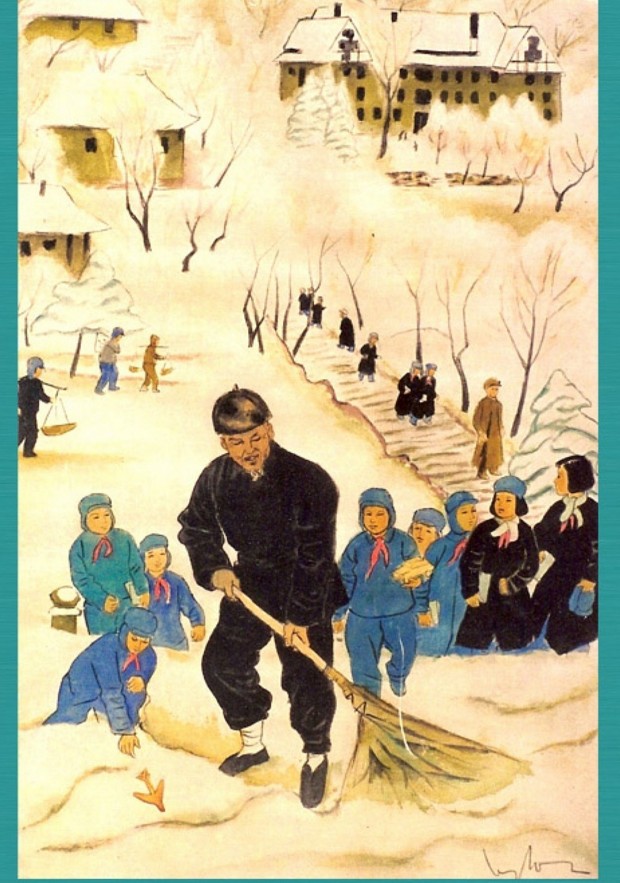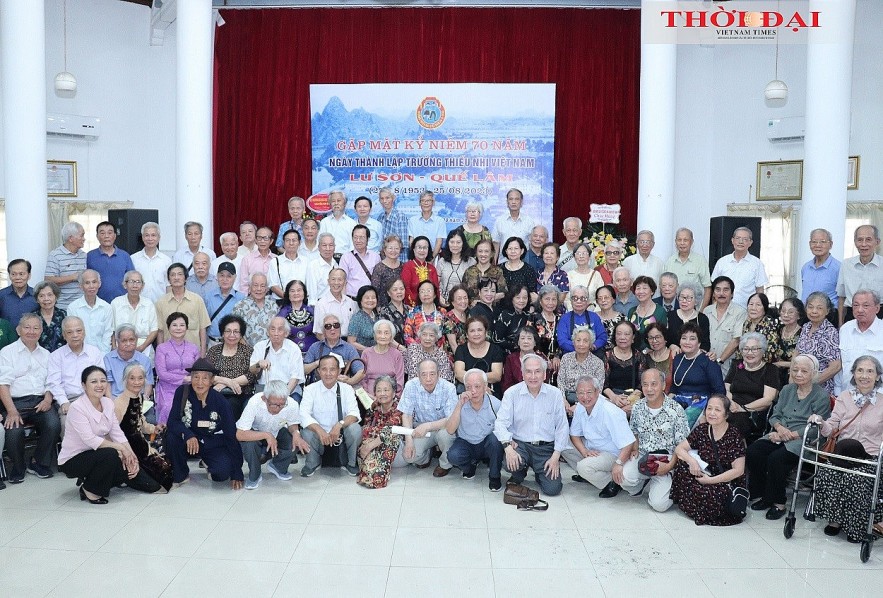 |
| “The Old Man Clearing Snow” by Le Nguyen Loi. |
“The old man was about 60 years old, with a rustic and gentle face. On slippery roads, he carefully led each student by the hand into the classroom,” Thuy recalled.
Moved by that action, artist Le Nguyen Loi, who was then a painting teacher, drew a painting called “The Old Man Clearing Snow.” In the painting, snow covers the roofs and trees, but only the student’s road to school is clean and clear of snow. The old man wore a dark outfit and looked intently at the broom. His agile, diligent appearance stands out against the white snow background and the snowflakes fluttering in the sky. Around him, students leisurely walked to school.
She no longer remembers his name clearly, but later on, whenever she saw snow in any country, Thuy often remembers the painting “The Old Man Clearing the Snow” and Lushan – where she saw snowfall for the first time in her life.
The old man clearing snow also became a source of poetic inspiration for many former students of Lushan-Guilin Vietnam Children’s School, including the poem “Snow Slope” by Vu Quang Trung. The poem has a line: “The old man shovels snow in Lushan/His feet wear canvas shoes, and a worn cotton shirt/The hood does not cover his gray beard/I still meet people on slippery slopes/The old bamboo broom sweeps away the thick snow/Helps each child led each hand/Tossing the children through the snowy slope/Who knew he was drenched in sweat?
Thuy often tells her children and grandchildren that the years studying at Lushan-Guilin Vietnam Children’s School were the most beautiful times of her life.
She said that in 1953, at 13, she left her family to study abroad in China. The road to Lushan (Jiangxi province, China) was arduous and dangerous. The students were of different ages, so older students helped the younger ones. There were children whose teachers had to carry them on their backs or let them sit in baskets.
According to her, the Chinese people are very dedicated, considerate, and thoughtful, providing the school with blankets, mattresses, warm clothes, and a heating system and hot water in the house. However, Vietnamese students still cannot get used to the cold and snow, and many of them have swollen feet. Therefore, the school moved to Guilin (Guangxi province, China). The local government sent good officials to help the school. Far from home, far from the Fatherland, the students are cared for by teachers and assistant staff from Vietnam and China instead of their parents.
 |
| Nguyen Thi Le Thuy (fifth from left, second row) at the meeting to celebrate the 70th anniversary of the founding of Lushan-Guilin Vietnamese Children’s School. (Photo: Thu Ha) |
“Chinese people back then were difficult and needy, but they were willing to give their food and clothes to the Vietnamese people. In the morning, our children ate dumplings and porridge and had meat and fish for lunch and dinner. We were fully educated in literature, physical education, aesthetics, health training, especially independence, learning habits, and working according to time and plans. We remember the days when Hua and Tong came to class to teach Chinese, remember Uncle Khong happily cooking by the fire for each meal, and remember Dr. Dang dedicatedly taking care of the health of Vietnamese children… Although the time studying in Lushan-Guilin was short, it created a solid foundation for me to self-study, strive, and improve myself. But the most precious thing is the emotional attachment to friends and teachers at school,” Thuy said.
|
The beautiful memories of Vietnamese students who studied in China will be preserved and turned into books and documentary films by the Guangxi Academy of Social Sciences (China). This information was given at a working session between the Vietnam – China Friendship Association and the delegation of the Guangxi Academy of Social Sciences (China) led by Tran Lap Sinh, President of the Academy on on December 20 in Hanoi At the reception, Tran Lap Sinh said that the Institute is implementing a research project, collecting historical documents of former students who studied at Vietnamese schools in Guangxi. Therefore, the working delegation hopes that the Vietnam-China Friendship Association will support and provide contacts to interview 80 former students. Thereby, the Academy will collect information about the lives of former Vietnamese students in China. These documents will be published as Vietnamese-Chinese bilingual books and made into movies. Ambassador Nguyen Van Tho, Vice Chairman of the Vietnam-China Friendship Association, asked the Institute to share specific plans for this project. He said the project will contribute to introducing the people of the two countries, especially the younger generation, to understand the traditional friendship between Vietnam and China and the help of the Chinese people to Vietnam during the two resistance wars as well as the feelings of Vietnamese students and teachers who have studied and taught in China towards the people of China. |
Ho Chi Minh City Tourist Numbers Decrease 12% Due to COVID-19 Worries
The number of tourists paying a visit to Ho Chi Minh City during the Lunar New Year (Tet) has suffered a decline of approximately 12 per cent as a result of the ongoing novel coronavirus (nCoV) situation.








